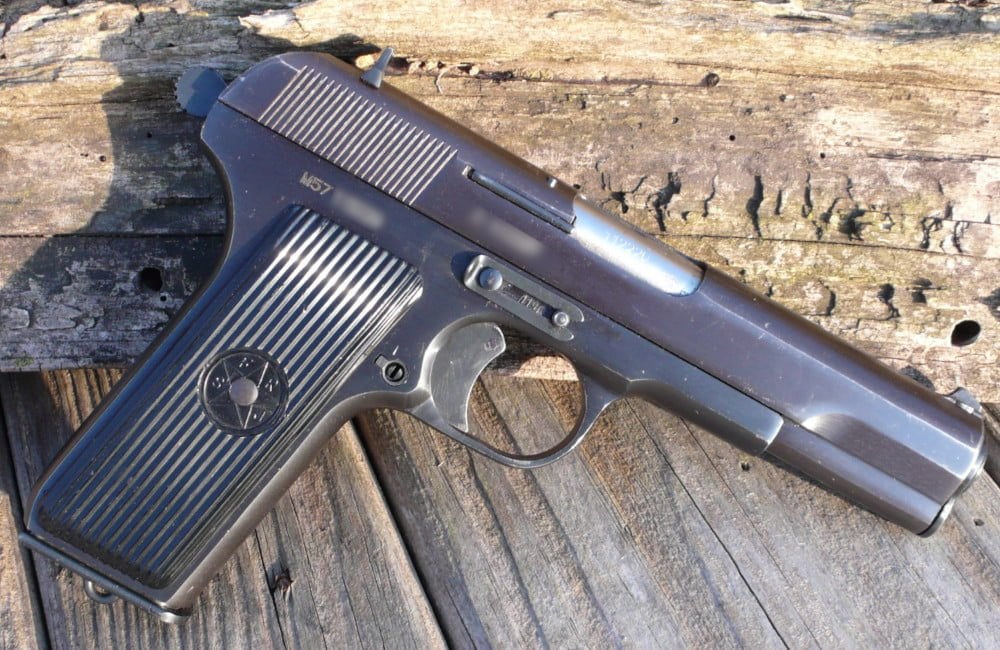The Zastava M57 is a unique and reliable pistol that draws inspiration from the classic Soviet TT-33 design. Chambered in powerful 7.62x25mm caliber, this firearm was initially intended for use by the Yugoslavian Army and law enforcement agencies.
Introduction
In 1946, Yugoslavia developed a plan for procuring weapons and military equipment from the U.S.S.R. From Moscow, the country received 31,050 TT-33 pistols and Nagant M1895 revolvers, among other items, using a loan of 78,000,000 dinars. In October 1947, Yugoslavia determined its “Plan (production) of the military industry for the period 1947-1951” and adopted it in March 1948. This plan called for the production of the Soviet 7.62mm TT-33 pistol and the construction of a special line for producing 7.62mm pistols and automatic weapons. The planned acquisition of funds from 1947 included those that could not be quickly produced within the country.
Experimental model 7.62mm M1954
The breakdown of relations between Yugoslavia and the U.S.S.R. in 1948 led to the revision of Yugoslavia’s plan for procuring weapons from Moscow. In response, the General Staff of the Yugoslavian Army (J.N.A.) decided to independently develop documentation for the TT-33 pistol without a license at the Kragujevac factory (Enterprise 44). At the same time, the Užice company “Prvi partizan” (Company 11) began acquiring 7.62x25mm T.T. ammunition to support the J.N.A.’s weapons needs.
According to the amended plan, dated September 24, 1949, a single production line for hand launchers, rifles, submachine guns, automatic weapons, and pistols was to be established in Kragujevac. This production line was intended to help the J.A. meet its weapons needs following the breakdown of relations with the U.S.S.R. It is worth noting that the breakdown of relations with the U.S.S.R. was a significant event that had a major impact on Yugoslavia’s weapons procurement efforts. The decision to independently develop documentation for the TT-33 pistol and establish a production line in Kragujevac were both part of the country’s efforts to address this issue and ensure that it had the necessary weapons to defend itself.
In 1952, the design team at the Kragujevac institute in Yugoslavia began working on its weapon based on the Soviet post-war TT-33 pistol. The TT-33 was modified in 1946 to lower production costs. The main changes were to the trigger mechanism and the cover, which had its alternating wide and narrow notches replaced with uniform little notches. The design and development of the Yugoslavian pistol, named the 7.62mm M54, was a direct copy of the TT-33 and was completed in February 1954.
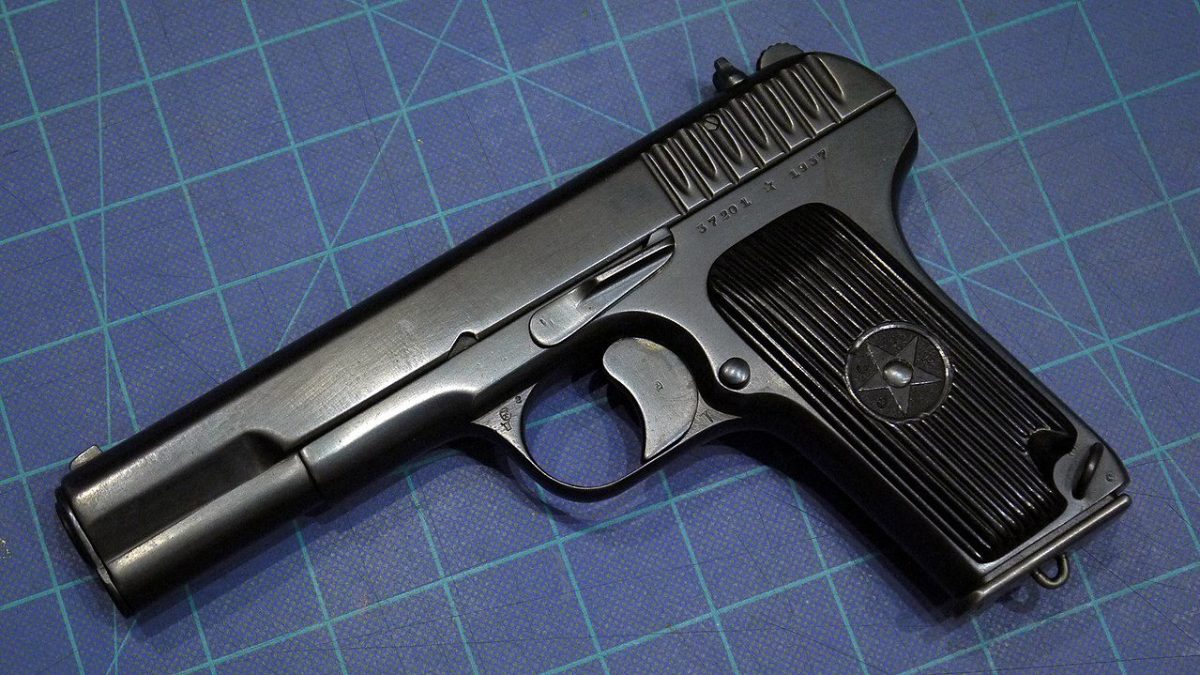
At that time, there was a significant shortage of pistols in the Yugoslavian Army (J.N.A.). For example, in 1953, the J.N.A. had 31,050 TT-33 pistols with 2.8 combat sets (B.K.) of ammunition, which was only enough to meet 9% of the army’s needs. The military required 343,805 firearms. Three years later, the army needed 365,056 different pistols but only had 29,949 (occupancy rate of 8%). By the end of 1960, according to the new formation, the army had 21% guns with ammunition for 207 days of the war.
Unfortunately, production of the 7.62mm M54 pistol could not begin as all the production lines at the Kragujevac factory were redirected to the production of M48 and M49 automatic rifles (later M49/57). This was likely due to the pressing need for these weapons, which were likely seen as more critical for the country’s defense.
M1957 (M57)
In the autumn of 1956, the Infantry Directorate ordered the “Military Technical Institute of the Land Army” (VTI KoV) to restart a pistol project based on the Soviet TT-33. The VTI entrusted the development and production of the weapon to the “Crvena Zastava” Institute, which was fully equipped with the necessary personnel and technology. The “Zastava” design team, led by Milos Ostojic, began work on the gun, designated Article 12, in 1957. The experimental model was developed in 1960, and in 1961, a small experimental series of 100 pistols, known as the 7.62mm M57, was produced for testing purposes. The gun passed all the tests, but orders from the State Secretariats for Defense and Internal Affairs did not follow until a few years later. Serial production of the M57 pistol began in 1963. At the time, the J.N.A. still had Soviet models in its arsenal. Hence, the Infantry Directorate of the State Secretariat for National Defense Affairs prescribed using the M57 and the M33 TT pistols on April 15, 1963.
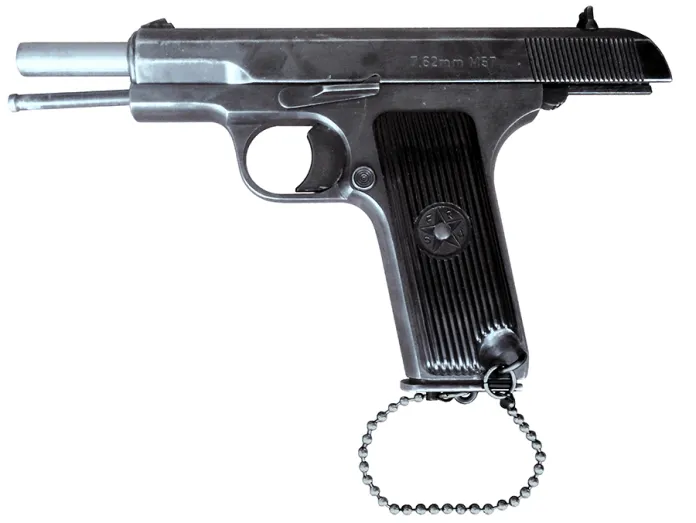
The 7.62mm M1957 pistol was officially adopted as the official weapon for officers and non-commissioned officers (as of 1970) and members of the military police. Later, after the introduction of a lighter “officer” model in 7.65mm caliber (M69/70), the M57 was assigned only to non-commissioned officers and soldiers according to regulation (until 1995-1997), as well as members of the Public Security SUP/MUP (until 1995). However, despite favorable administrative regulations, the Secretariat of Defense ordered the first batch of 48,500 M57 pistols from 1966 to 1970.
The M57 pistol was developed using the Soviet TT-33 as a starting point, with several improvements and changes to its design.
Construction
The M57 pistol operates on the principle of short recoil of the barrel and locking with the fall of the barrel in the vertical plane. The barrel is closed to the slide using two annular outlets on the barrel and corresponding grooves in the slide, and it is “swung” by a coupling on the lower rear part of the pistol. The slide is made as a single piece with a zipper. The handle, or magazine, has holes for mounting the barrel, slide and handle, secured on the right side by a split spring connector stabilizer. The single-action cocking and firing mechanism, with an open striker, is a separate block consisting of a body that houses the striker, shaft with the striker spring, fire separator, and catch with the spring.
The M57 pistol has a bolt retainer and slides in the rear position after firing the last round from the magazine, as well as protection against accidental firing by pulling (or lowering) the striker on the second tooth of the sear. Like the Soviet model, the official domestic model has no other external mechanical safety features. However, it should be noted that the placement of the firing pin on the second tooth (as a safety measure) has the disadvantage that, in the event of the weapon being dropped on a solid surface, the tooth could break and cause the pistol to fire uncontrollably.
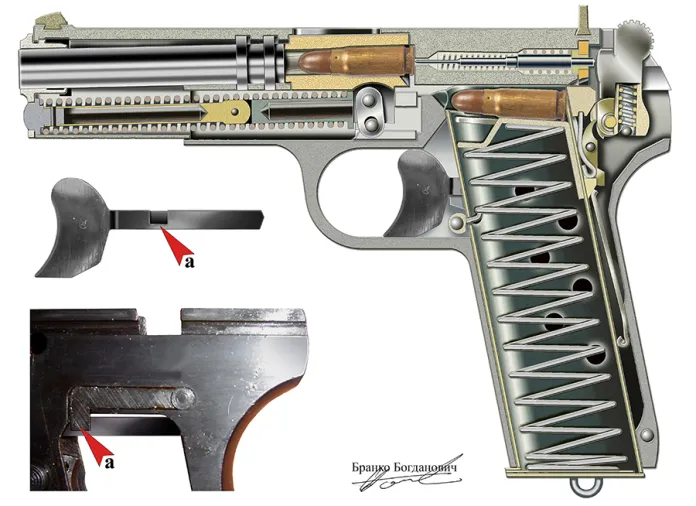
On the Yugoslav model of the M57 pistol, a novelty was the so-called “automatic brake” that blocked the trigger and prevented it from being released when the slide was outside the handle. When the magazine is removed from the handle, the spring brake is freed from the pressure of the magazine, and its tooth enters the notch on the trigger lever, blocking the trigger and the detent. This solution may not meet modern requirements for combat weapons, as the pistol cannot be used without the magazine (for example, manually inserting a bullet into the magazine).
In contrast, the guide with a return spring on Soviet weapons was immovable and lay in the groove of the grip, resting its head on the wall of the groove. The return coil spring was free around the guide, with the front end resting on the support of the return spring (which went into the lower opening of the guide sleeve) and the rear end resting on the head of the guide. The M57 pistol used a different solution for the recoil mechanism in the form of a block. The return mechanism consists of a return spring, support, arched rim, and a two-armed guide. The spiral spring is placed around the guides and is not intended for disassembly; one end rests against the support and the other against the rim. The guide consists of a leading and movable shaft, connected by a pin.
In the TT-33 pistol, the firing pin is placed in the tunnel of the bolt body and secured by a split pin that extends transversely over the longitudinal slot on the body of the pin, limiting its travel along the length of the slot. However, this solution can lead to breaking the firing pin, weakened by the slot, or the pin falling out. The M57 pistol uses a different design in which the firing pin has a body with a complete circular profile, without weakening. There is a spiral needle spring on the front part of the pin, and a tile and tile fixing spring on the back. The lower part of the plate goes into the shutter body, and the upper part accepts the transition between the two diameters of the fastener, securing the entire assembly.
The sights on the M57 pistol are of the open type, with a front sight mounted on the slide with a “swallow tail” connection and a rear sight also mounted on the slide in the form of a “swallow tail,” allowing for adjustments in the direction. The M57 handle is extended by 14 mm compared to the TT-33 and M54, allowing it to accept a magazine with 9 rounds (compared to 8 rounds on the TT-33). The longer grip is more ergonomically suitable for shooters with large hands. However, the slope of the grip on the M57 has not been changed from the basic model, maintaining an angle of 105° even though it is known that a more suitable inclination angle is between 110 and 115°. On the lower left side of the handle is an archaic semicircular loop for a ring, which was used according to the domestic rule for pistols “to fasten the pistol when it is in the holster.” On the TT-33, the lanyard was used to fasten a lanyard worn around the neck to prevent the pistol from being lost in battle, an “idea” taken from the Nagant M1895 system revolver.
On the first series of M57 pistols, the magazine lock button (consisting of a body with a button, spring, and tooth) was impractically large and insufficiently protected. This led to the accidental release of the magazine, which could cause the front of the slide to fail to insert a bullet into the magazine or even result in the complete loss of the magazine. In later series, the ergonomics of the button were improved, and its seat was deepened to prevent this issue. Militiamen who carried weapons daily in the service protected themselves from this issue by securing the magazine (using the semicircular outlet at the bottom of the magazine) with a chain to the otherwise useless link on the handle.
The holsters for the M57 pistol produced from 1963 to 1968 (serial numbers 0001A to E58,000) had small print 7.62mm M57 on the left side and the coat of arms of the Federative People’s Republic of Yugoslavia (F.N.R.J.) with five flames on the top. The weapon comes with a black plastic scabbard with longitudinal grooves featuring a pentagram in a circle around the fissuring screw with the abbreviation “F.N.R.J.” between the arms.
It is interesting to note that the name of the country was changed by the Constitution of April 7, 1963, to the Socialist Federal Republic of Yugoslavia (S.F.R.J.), and a new coat of arms with six flames was adopted. However, the coat of arms on the upper part of the scabbard and the abbreviation between the arms of the star on the slide were not changed until three years later, from serial number 58.001. This is because the design drawings for the weapon were completed in 1960, the “0” series was made in 1961, and serial production began in April 1963, using the coat of arms and name current at the time of the tool’s manufacture. It took the factory five years to update the features of the weapons.
The serial number of the M57 pistol was inscribed on the right side of the holster and grip. In addition, each part of the pistol had its catalog number for ease of assembly and potential replacement, while vital parts were stamped with the military control stamp “V.K..” Despite objections to the Tokarev system and the 7.62x25mm ammunition, “Zastava” from Kragujevac experienced great commercial success with the M57 pistol. It was eventually replaced in official use in the army and police by the “Zastava” CZ-99 pistol at the end of the 20th century. Still, it remained popular in the commercial market for a long time. To export to foreign markets, “Zastava” also developed several commercial variants of the M57 pistol, which was commonly known as the “Tetej” (after the Soviet TT-33 model).
Commercial variants
The development of the commercial version of the M57 pistol began in 1965 at the “Crvena Zastava” Institute in Kragujevac. The first models intended for the wider market were the 7.62mm Mod.75 and “7.62mm Mod.60” pistols, which were still based on the 7.62x25mm T.T. bullet. The main changes about the official weapon included inscriptions on the left side of the slide reading “ZAVODI CRVENA ZASTAVA” or “Z.A.S.T.A.V.A./Made in Yugoslavia” and the caliber mark on the right side. The black plastic slide, with standard longitudinal grooves, had the pentagram in the circle replaced by the factory abbreviation – “Z.C.Z..”
In 1968, the institute began work on the “Article 04” project, a pistol chambered in the popular 9x19mm cartridge known as the “9mm/d/ Mod.60”. A small batch of 375 M1960 9mm pistols was produced that year.
“Zastava,” a company that develops commercial weapons, primarily had the largest market in mind when creating its products – the U.S. market. As a result, the company’s pistols had to be adapted to the strict regulations of the Bureau of Alcohol, Tobacco, Firearms, and Explosives (A.T.F.). Following these regulations, “Zastava” retrofitted its M60 pistols with mechanical brakes and renamed them the “9mm/d/ Mod. 60A” and “7.62 mm Mod. 60A”.
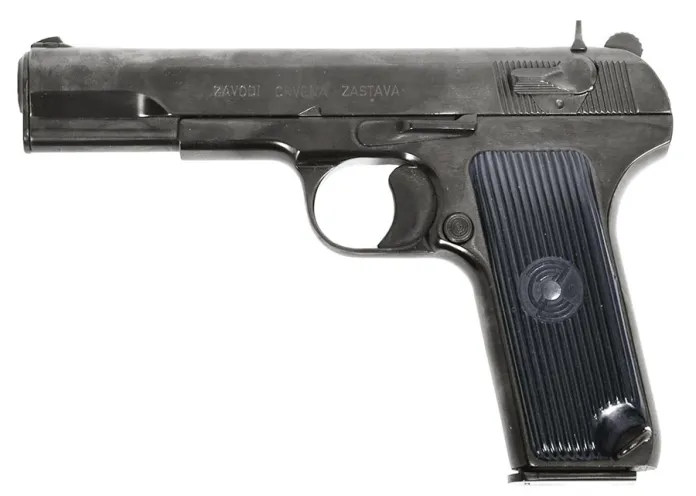
In the experimental models with the suffix “A,” the brake lever was initially placed on the left side of the handle above and behind the trigger. However, on the weapons that entered serial production, the brake button was moved to the back, above the rear upper end of the cover. The brake had a knurled knob, a lever, and a tooth. To activate the brake, the lever had to be moved upward. In this position, the brake tooth would block the detent, and the detent tooth would enter the safety notch on the firing pin. Additionally, the safety tooth would lift the spacer into the breech opening, thereby blocking the sleeve.
However, according to A.T.F. regulations, the pistol’s brake must be placed on the gun’s holster. To meet this requirement, “Zastava” constructors created the “Mod. 65” pistol in 1969, chambered for 9x19mm and 7.62×25 mm T.T. ammunition. The following year, the pistol was renamed the M70A. In 1970, all “Zastava” commercial pistols based on the Soviet TT-33 received the common name M70, while pistols with an additional mechanical brake carried the suffix “A” from before.
The M70A (M65) pistol differed from the M60A in that the brake was placed on the rear left side of the magazine. When the brake was applied, the mechanism for engaging and releasing the shutter with the cover was blocked.
P.W. Arms M-57 Zastava
After the 7.62mm M57 pistol was withdrawn from official military and police use, many weapons were sold on the open market. At the beginning of the 2000s, the gun was worth about 100 euros on the free market in former Yugoslavia.
Following its regulations, the Ministry of Defense sold pistols from its warehouse through international tenders. At one such tender in 2010, Stacy Prineas, director of the American company “P.W. Arms Inc” (located in Redmond, WA), purchased the first batch of 5000 7.62mm M57 service pistols through the mediation of the Belgrade export-import company “Gim-Export-Import.”
However, due to existing rules set by the A.T.F., it was necessary to install a mechanical external brake on the weapon before it could be transported, i.e., imported to the U.S.A. Based on ideas from Branko Bogdanovic, a master at the Kragujevac institute, Dobrica Krstic constructed a mechanical brake that was installed on all 5000 pistols. The adaptation work was carried out by the Belgrade company “Trofej-Commerce”. The brake was mounted on the rear left part of the handle. At the same time, the upper rear inner side of the left cover was thinned, creating a gap between the cover and the magazine that allowed for the smooth operation of the structure.
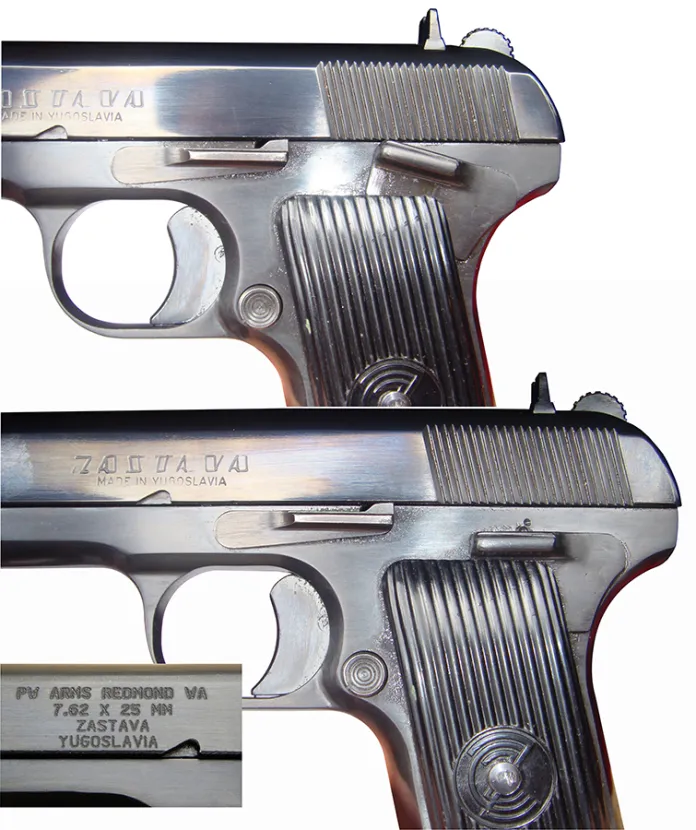
The brake consisted of a carrier plate with a longitudinal checkered button, a bolt detent tooth, and a shaft. When the brake button was lifted, the brake tooth would lock the detent and striker (the tooth would engage the safety slot of the striker). In addition, the separator would rise and enter the opening of the shutter, blocking the cover – the shutter.
On the left side of the sleeve, the inscription “PW ARMS REDMOND WA / 7.62 x 25 mm / ZASTAVA YUGOSLAVIA” was subsequently added (although Yugoslavia no longer existed at that time). All other inscriptions, as well as the cartouche on the cover, were left untouched. As it was an official weapon, the inscription “7.62mm M57” and a cartouche with a star and the abbreviation “S.F.R.J.” were still present.
Since 1988, “Zastava” has continued to improve and adapt the M57 weapon for the commercial market. This is how the M88, M88-A, M-70 Combat, Zastava P-10 (Z-10), Zastava M-97, and P-45 pistols were developed. But the story of this weapon continues in the history of “Zastava’s” pistols.
Technical data for commercial variants
Country of origin: Yugoslavia
Manufactuer: Crvena Zastava now Zastava Arms
Caliber: 7.62 or 9 mm;
Magazine capacity: 9 rounds
Gun length: 200 mm
Height: 130 mm
Barrel length: 116 mm
Number of grooves: 4 (on a 9 mm caliber pistol – 6),
Pitch of grooves: 240 mm
Weight without a frame: 854 g
Production of M57 from 1963 to 1982
| Year: | Number: | Serial number: | Grip panel/slide: |
|---|---|---|---|
| 1963 | 6500 | A–0001 A–6500 | On the grip panel is the national coat of arms of the Federal People’s Republic of Yugoslavia (F.N.R.J.) with five flares. In the center of the circle is the party symbol with five points. The abbreviation “F.N.R.J.” is located between the arms of the star. |
| 1964 | 12.500 | B–6501 B-19.000 | |
| 1965 | 13.000 | C-19.001 C-32.000 | |
| 1966 | 13.000 | D-32.001 D-45.000 | |
| 1967 | 13.000 | E-45.001 E-58.000 | |
| 1968 | 13.000 | F-58.001 F-71.000 | On the cover is the national coat of arms of the Socialist Federal Republic of Yugoslavia (S.F.R.J.) with six flames. In the center of the crest is a circle with five points, with the abbreviation “S.F.R.J.” between the arms of the star. |
| 1969 | 19.000 | G-71.001 G-90.000 | |
| 1970 | 19.000 | H-90.001 H-109.000 | |
| 1971 | 19.000 | I-109.001 I-128.000 | |
| 1972 | 4000 | J-128.001 J-132.000 | |
| 1973 | 8000 | K-132.001 K-140.000 | |
| 1974 | 8000 | M-140.001 M-148.000 | |
| 1975 | 19.000 | N-148.001 N-167.000 | |
| 1976 | 19.000 | N-167.001 N-186.000 | |
| 1977 | 19.000 | N-186.001 N-205.000 | |
| 1978 | 19.000 | N-205.001 N-224.000 | |
| 1979 | 19.000 | N-224.001 N-243.000 | |
| 1980 | 19.000 | N-243.001 N-262.000 | |
| 1981 | 4000 | O-262.001 O-266.000 | |
| 1982 | 4000 | P-266.001 P-270.000 |
